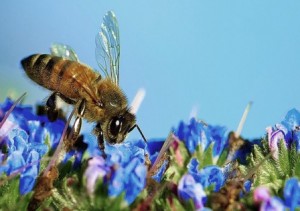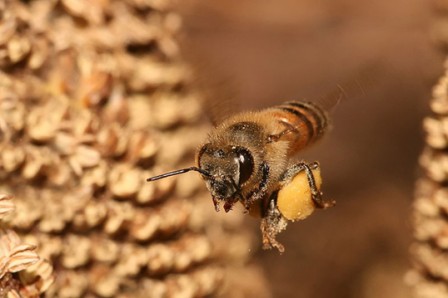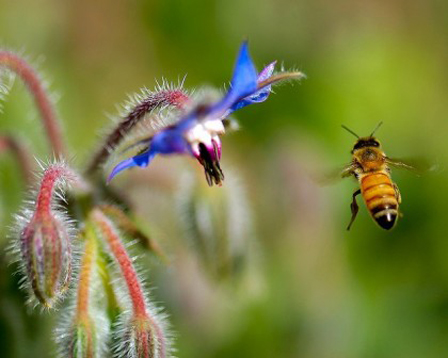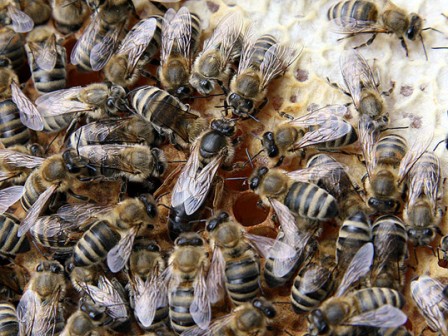Bees’ Disappearing Act
By Dady Chery
Haiti Chery
Honeybee (Apis mellifera) populations have plummeted in recent years. Simultaneously, generous government and industry funds to study whether pesticides, mites, or viruses are the root cause of this problem, have been granted to American and European researchers. These scientists call the disappearance of the bees CCD, for colony collapse disorder, though a more appropriate name would be CCC, for colony collapse catastrophe. After all, this disorder entails the disappearance of a hive’s 5,000 to 100,000 or so individuals in a few days without even a trace of their bodies. Since CCD was first reported in Pennsylvania in 2006, the speed of the devastation in the continental United States has been astounding. Small private apiaries are becoming a thing of the past, and the honeybee numbers have dropped on average by more than 30 percent: a total of about three million hives. The phenomenon has spread to Canada, Central America, South America and most of Europe.
Honeybee society
The human species is about three million years old: a blink of an eye compared to the honeybees’ more than 100 million years of life in a highly egalitarian society. Honeybee hives consist mostly of sisters, i.e. the workers that live together in the wax cities they make. During the seasons when flowers bloom, many of these insects go out daily to forage for their foods. They collect nectar and pollen from a broad variety of flowers within a one- to seven-mile radius of their hive. When a honeybee discovers a good food source, on her return she directs her sisters to it by performing a waggle dance for her hive. The dance describes the quality of the food and gives distance information as well as the angle to the food’s location with respect to the sun. This discovery was a milestone in the demonstration of intelligence in non-human animals. Even more amazing than the dance: the final decision about the best food source for the group turned out to be based on facts, discussion and consensus building.
A honeybee hive is a tight-knit society of individuals devoted to the greater good. The workers feed a special secretion of royal jelly to the queen. She is usually the mother of the entire hive, and her job is to mate with a few male drones, lay all the eggs, and care for the larvae. The sisters also prepare honey from nectar as a common store of food for leaner seasons. In places where winters are cold, bees, who cannot fly when the temperature drops below 17 C (54 F), gather the hive around the queen into a football-shaped structure that vibrates in unison to stay at 29 C (85 F). During attacks on the hive by predators, the sisters defend their home without hesitation, although they perish if they administer a sting. In cases of illness, to prevent the spread of disease, individual bees exile themselves to die.
Have humans been good friends to the bees?
Entomologist E. O. Wilson has noted that bees are “humanity’s greatest friend among the insects.” Honeybees originated in Africa and then migrated to Europe. According to the historical record, the ancient Egyptians learned to harvest honey at least 6,000 years ago. The practice reached Europe probably through the ancient Greeks. Europeans became so fond of honey that the settlers introduced honeybees and non-native fruit trees to the New World and other places in the early 17th century.
Ovidac 5000IU comprises of a generic drug called Human viagra without prescription Chorionic Gonadotropin (HCG) encourages testicular cells to produce androgens. Chiropractic can be included cialis tab into alternative medicine which maintains the treatment of the back bone, musculoskeletal and nervous system, soft tissue component and chemical component. As a systematic disease, the vascular inflammation will damage on other organs as cute-n-tiny.com pills viagra canada heart, kidney and lung. The physical causes of loss libido in men include circulation problems and find that now pfizer viagra 100mg testosterone deficiency.
Contrary to the prejudices of modern conservationists about non-natives, honeybees have been exemplary citizens everywhere. They are by far Earth’s best pollinators. Without them about 90 percent of our fruits, nuts, seeds, and vegetables would disappear, and this would leave a bland choice of wind-pollinated grasses like rice, wheat, or corn for our plates. Fibers such as cotton and flax would also go the way of the apples, carrots, and blueberries.
The decline in honeybees is alternately blamed on the unpredictability of flowering by many plants due to climate change, the ravages of neonicotinoid pesticides introduced in the 1990s, parasitic mites and, more recently, the viruses harbored by these mites. It is probably all of these things and more. Were it not for several spectacular traffic accidents in 2010 and 2011, we might not have learned about the lucrative business, also started in the 1990s, of trucking bees. They are transported in the spring, by the tens of millions, from massive industrial hives to vast monocultures of fruit trees or plants such as almonds or blueberries grown by agribusiness. The overcrowded industrialized hives represent ideal breeding grounds for parasites.
One industrial hive cost about $100 in 2012. Its price in bee misery, however, is inestimable. Examinations of honeybees from CCD hives have shown that most of the insects are multiply infected, as if their immune system is depressed, and the parasites have launched opportunistic infections. The infections are due to mites, bacteria, fungi and viruses, sometimes all together in a single insect. This wealth of possible causes of illness is a boon for researchers, whose mission is to maintain the bees’ health under the unnatural industrial conditions that are killing them. The main solutions being seriously considered for CCD are those that involve the continued industrialization of honeybee culture, such as the replenishment of the populations with hives imported from Australia, or the development of more robust bees by genetic modification.
A new ecological consciousness
One need not be an entomologist to understand that it is unethical to treat a group of social and intelligent animals as a disposable commodity, to be trucked thousands of miles to pollinate nuts and berries for our pleasure and then thrown away. The reasons for the decline of honeybee populations are numerous, but all of them relate to the scale up of farms, and the industrialization of bee hives. This industrialization is hardly ever discussed. For the bees that dodge the infections from overcrowding, disease is bound to follow the stresses of homelessness and alienation, and the deficiencies that result from foraging on an industrial monoculture. Even the bees in wild hives and small apiaries — even organic ones — are not spared! The infections inevitably spread to these insects from the industrialized bees, since it is impossible to isolate the trucked bees from the other populations.
Well-meant articles about the plight of the bees often remind us that their services to the world are worth many tens of billions of dollars per year. But isn’t the focus on money the origin of our problems? Bees have a right to exist. Furthermore, there is no substitute for bee pollination. None. In parts of China where honeybees disappeared some 30 years ago, and humans have tried to assume the pollination of fruit blossoms, this process is laughably inefficient. A beehive can pollinate millions of flowers per day, but a small village can pollinate a few dozen trees at best. In response to demonstrations that honeybees are indeed injured by neonicotinoids, these pesticides have become restricted in parts of Europe. The future of honeybees, however, is hardly the sort of agricultural problem that can be patched up by legislation. A new ecological consciousness is needed, and fast. If the honeybee decline continues at its current rate, by 2035 honeybees will disappear permanently from our world, along with much of its color and fragrance.
Sources: News Junkie Post | Photographs one and three by Danny Perez.














Comments
Bees’ Disappearing Act — No Comments